Gaza Water Crisis
Air Date: Week of October 26, 2018
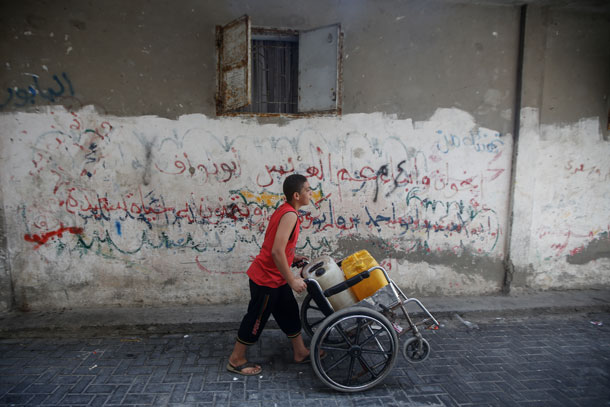
Mohammad Nimnim wheels water jugs, to fill at the mosque at Beach refugee camp. (Photo: Abdel Kareem Hanna)
In the Mideast’s hotly contested Gaza Strip, where three out of four people are refugees, access to electricity and clean water is severely limited. The unsafe drinking water has led to a worsening health crisis for Gaza’s children, who suffer from diarrhea, kidney disease, stunted growth and impaired IQ. The problems include the lack of electricity to run Gaza’s sewage treatment plant, and the long-running conflict between Israelis and Palestinians. Sandy Tolan reports from the Gaza Strip.
Transcript
CURWOOD: It’s Living on Earth. I’m Steve Curwood.
Nowhere is the seemingly endless crisis between Israelis and Palestinians more acute than the Gaza strip, a hotly contested piece of land just 25 miles long and roughly 5 miles wide. Thousands of buildings were destroyed and more than 2200 Gazans were killed by Israeli forces in the 2014 war, with 71 deaths on the Israeli side. Twenty-one years ago, we sent reporter Sandy Tolan to Gaza to document the acute shortage of drinking water there, and back then he found that 85 percent of wells were too contaminated for human consumption. He recently returned and now that figure is up to 97 percent. Here’s his report.
TOLAN: The Shati refugee camp stretches for about a mile along Gaza’s Mediterranean coast. Shati means “beach” in Arabic, but it’s hard to find a cool ocean breeze here. The 87 thousand people squeezed into half a square kilometer of cement block dwellings are all refugees and their descendants. Of Gaza’s nearly two million people, three out of four are refugees - families forced to flee their towns and villages during the creation of Israel in 1948.
[WOMAN’S VOICE IN ARABIC]
TOLAN: Fatemah Nimnim was three when her family was driven out of the village of Hamama; she doesn’t remember much besides the refugee camp, where she now lives with three younger generations. They share three small rooms.
NIMNIM: Welcome! We are honored to meet you. May God give you health…
TOLAN: Today the entire family greets us in the front room – nineteen members of the Nimnim family. Most sit on the floor, backs against paint-chipped walls. They introduce themselves.
[NIMNM INTRODUCTIONS]
TOLAN: Today it’s 94 degrees and it’s really humid. It feels, unbearable.
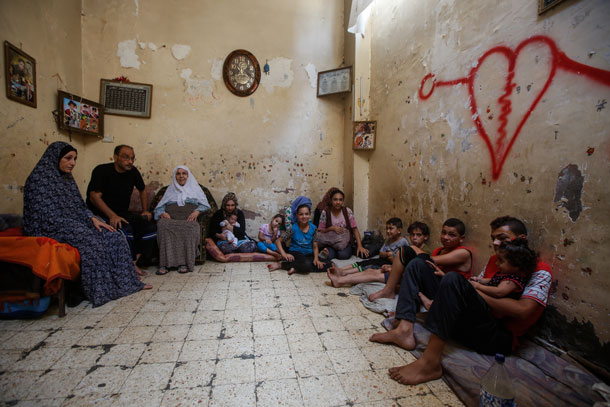
Fifteen members of the Nimnim family, at home in the beach refugee camp. (Photo: Abdel Kareem Hanna)
NIMNIM: It's hot, suffocating. There isn't enough space to sleep. There's no space at all, can you see.
TOLAN: There’s no fan, because electricity in Gaza comes just four hours a day, says Fatemah’s son, Atef Nimnim.
A. NIMNIM: Water and electricity? Forget about it. There isn’t any.
TOLAN: The water that comes out of the tap is way too salty to drink. That’s because the aquifer below our feet has been over-pumped so badly that seawater is flowing in.
[WHEEL CHAIR SOUNDS]
TOLAN: So, to quench the family’s thirst, 15-year-old Mohammad Nimnim piles plastic jugs into an old wheelchair and rolls it to the mosque, where sputtering taps provide the most basic necessity for life -- courtesy of Hamas.
[WATER SOUNDS]
TOLAN: For most people in Gaza, it’s not quite as dire. Two thirds of Gazans get water delivered by truck. Desalinated water is pumped into rooftop tanks via hoses.
[WATER GOING INTO A TANK]
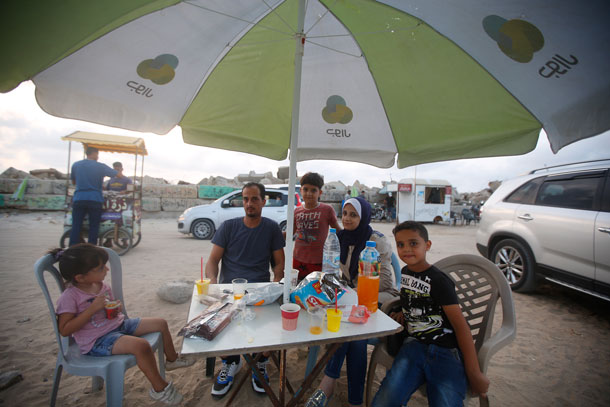
Children gather under an umbrella in the Shati (beach) refugee camp. (Photo: Abdel Kareem Hanna)
But when it comes to water in Gaza, better off is only by degree. The desalinated water is unregulated. And because this water has virtually no salt, it’s prone to fecal contamination, says former Palestinian deputy water minister, Rebhi Al Sheikh.
SHEIKH: And when it is a stored at the household water tank for many days more than 10 days then this level of contamination can reach up to 70 per cent.
TOLAN: That’s seven in ten people basically drinking poop, or e. coli if you prefer. And in terms of parts per million, UNICEF’s Gregor von Medeazza says the only really safe level is zero.
MEDEAZZA: So, already the presence of one is too much. Why? Because the moment you have one you actually have a potential for growth depending on how long you've got your water standing or sitting rather in those tanks.
TOLAN: I caught up with Gregor as he rode out to inspect new water projects in southern Gaza.
MEDEAZZA: The longer they are there the more you've got them protozoa you've got all sorts of other then little animals that actually start growing in your water and it just gets worse.
TOLAN: When children drink this water, they start getting the runs.
MEDEAZZA: So if you have repeated diarrhea the end result is actually your child would not grow to its full potential. You actually see children being stunted. What it also means is actually impediment in terms of brain development. You would actually have a measurable impact on the IQ of those children as they grow.
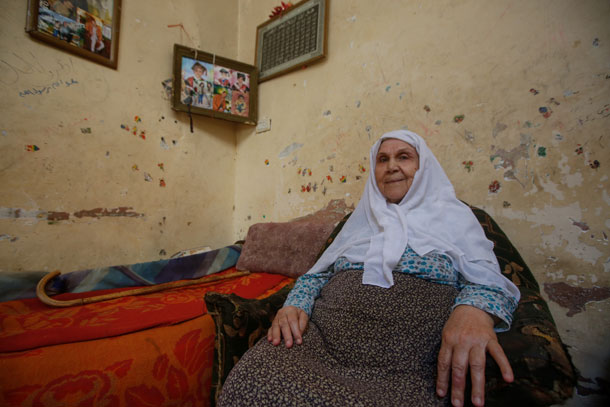
Fatemah Nimnim, family matriarch. (Photo: Abdel Kareem Hanna)
TOLAN: Late last year a British medical journal found an “alarming magnitude” of stunting among Gaza’s children. And that’s just one effect.
[HOSPITAL SOUNDS, KIDS CRYING]
Gaza pediatrician Mohammad Abu Samia says say there are so many others.
SAMIA: In the summer day the hospital is very very very busy.
TOLAN: Dr. Abu Samia takes us through the children’s ward in Al Nasser hospital in Gaza city. He stretches out his hand, touching a baby girl hooked up to a respirator. Alone in her hospital bed, she looks even tinier. Some of these children have recently had heart surgery. The overwhelmed doctor says he’s seeing a sharp rise in disease and illness in children like gastroenteritis from the dirty water.
SAMIA: Baby suffering from dehydration, from vomiting, from diarrhea, from fever.
TOLAN: And because of the extremely high nitrate levels in the water, the doctor is seeing other effects.
SAMIA: We have children, kidneys not working now.
TOLAN: Before, he tells me, they had 15 or 20 cases at any given time. Now it’s 40.
SAMIA: Every day I have in the hospital ten babies in machine, in hemodialysis because of renal failure. And the number increasing.
TOLAN: And so are cases of something called blue baby syndrome. The high nitrate levels deprive the blood of sufficient oxygen. And so some babies look – blue.
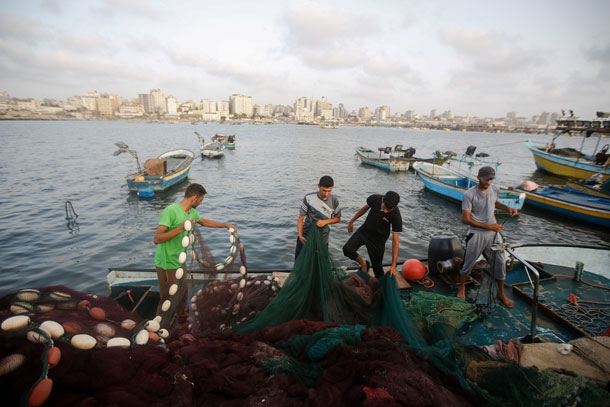
Fishermen in the Gaza harbor. (Photo: Abdel Kareem Hanna)
SAMIA: bluish lips bluish face bluish skin.
TOLAN: And blood the color of chocolate.
SAMIA: I see one or two kids the last ten years. But now I see five cases in the one year.
TOLAN: So. Sharp rises in Gastroenteritis. Stunted growth. Renal failure and hypertension from those high nitrate levels. Blue baby syndrome. And, Doctor Abu Samia says, he’s seen big increases in pediatric cancer – whether from water, the effects of three wars, he doesn’t know. And beyond the lack of water, he’s seeing the effects of malnutrition, which he blames on Israel’s economic blockade.
SAMIA: Nutrition is very bad. It is affected baby. Before siege, we don't have any patient with no malnutrition. Now we saw baby with marasmus. You know what is marasmus?
TOLAN: Marasmus is severe malnutrition, sometimes in newborn infants. Just skin and bone, the doctor says.
SAMIA: The last years increasing more and more.
TOLAN: Palestinian Health Ministry studies back up Dr. Abu Samia’s observations. They note a doubling of severe cases of diarrhea, especially in children, and “serious increases” in kidney disease, and in food and water borne diseases, including hepatitis A, salmonella, and typhoid fever. The British medical journal Lancet corroborates that shortages of clean, safe water have contributed to sharp rises in diarrhea among young children in the Gaza Strip. Diarrhea is the world’s second biggest killer of children under five.
HASNA: If you really want to change the lives of people you have to solve the water issue first.
TOLAN: Adnan Abu Hasna is a spokesperson for the UN agency for Palestinian refugees, UNRWA.
HASNA: Otherwise that you will see huge collapse of everything in Gaza.
TOLAN: Already Gaza is widely considered the world’s largest open-air prison.
HASNA: You can keep people in prison, surviving and giving them the minimum drops of water. Little of electricity, little of hope. Now I can tell you Gazans reach the level that people are thinking there is no tomorrow in Gaza. The. Kind of the dream you are not allowed to dream because your dreams will never be achieved will never be a reality.
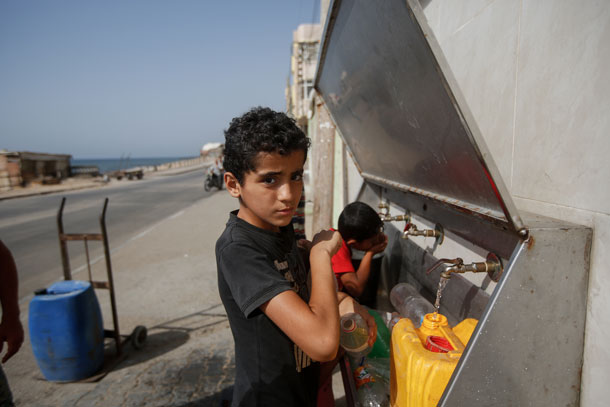
Children drink and fill water jugs at a mosque in Gaza City. (Photo: Abdel Kareem Hanna)
TOLAN: It may seem that Gaza’s torments are completely contained by layers of fences, locked gates, patrolling Israeli drones, war planes, and international indifference. But that’s not true.
One example: Because Gaza’s power plant runs only four hours a day, its sewage plant is basically useless. So, 110 million liters of raw and poorly treated sewage flow directly into the Mediterranean, every day –here on this beach, long pipes spew brown water into the ocean, just ten miles from Gaza City.
BROOMBERG: They are carried by the currents and north and the response was closing the beaches in Gaza itself.
TOLAN: Gidon Bromberg is director of Ecopeace Middle East, based in Tel Aviv.
BROOMBERG: A young five-year-old boy, unfortunately his family took him and the boy swallowed some water and within ten days he was dead. A virus got to his brain.
TOLAN: The child’s name was Mohammad Al-Sayis and Bromberg says some of the misery in Gaza does go beyond its borders.
BROOMBERG: It's led to the closure of beaches directly on the Israeli side of Sikkim.
TOLAN: Authorities even had to close an Israeli desalination plant for a time – because, who wants to try to desalinate water with poop in it?
Israelis, Bromberg says, need to wake up to the unfolding humanitarian disaster in Gaza.
BROOMBERG: It's a ticking time bomb. We have a situation where two million people no longer or no longer have access to potable groundwater. When people are drinking unhealthy water then disease is a direct consequence Should pandemic disease break out in Gaza people will simply start moving to the fences. and they won't be moving with stones or with rockets they'll be moving with empty buckets desperately calling out for clean water.
[PROTEST SOUNDS]
TOLAN: Assigning blame for the plight of Gazans is not exactly simple. Take the fact that three percent of Gaza’s drinking water wells are actually drinkable. Is that because Gaza’s citrus farmers pumped too much? Or because Israeli agricultural settlers depleted a deep pocket of fresh water before they left Gaza in 2005? Or the simple fact that Gaza’s population quadrupled in a matter of weeks when towns and villages fell to Israel in 1948?
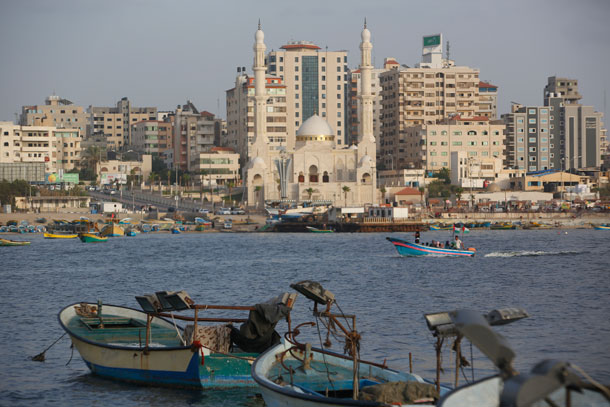
The Gaza harbor. (Photo: Abdel Kareem Hanna)
And how about the food and water borne diseases? That’s in part because the power is shut off for 20 hours a day. Do we blame Israel and Egypt for withholding fuel deliveries? Or Israel, for bombing water and sewage infrastructure in Gaza during the 2014 war? Or the fight between Hamas and the Palestinian Authority, which deprives Gazans of critical medicines?
And what about Israel’s economic blockade of Gaza, which human rights groups say contributes to worsening poverty, skyrocketing unemployment and child malnutrition?
A peace deal could have connected Gaza to the West Bank, where the vast Mountain Aquifer is big enough to end Gaza’s water crisis. As it is, there is no peace. The two Palestinian territories are splintered. And Israel has effective control over of the water.
Critics say Israel could solve the whole problem by simply building big water and power lines into Gaza. But Israeli officials say they are already sending water to Gaza – and to do more would be rewarding Gaza’s bad actors.
SHOR: My name is Ori Shor. I am the spokesperson for the Israeli Water Authority. What's going in Gaza is a real catastrophe. The situation there is unbearable but it's also frustrating at least from our point of view. because it's a bit difficult to help someone that doesn't want to help themselves. The problem in Gaza is really that there Hamas people do not do nothing in order to try even to solve the problem.
The obligation of Israel in this agreement that we have. To provide a certain amount of water to Gaza and certain amount of water to the West Bank. Israel is providing it and they're providing more than twice the amount that we are obliged by our agreement.
That amount is just a fraction of the clean water Gazans need every day. And so, the situation in Gaza continues to deteriorate. Humanitarian groups estimate that Gaza will become uninhabitable by 2020 – barely a year from now. To avoid that international relief agencies, and the Palestinian water authority, are working on a network of big sewage and desalination plants.
MOAMAR: This is the feed water from the storage tank…
TOLAN: This is Kamal Abu Moamar, manager of the South Gaza Desalination plant. It’s a small first step. Eventually there would be a half dozen, along with big sewage plants -- $500 million dollars with, all funded by international donors. But my visit doesn’t inspire confidence. It’s quiet. We can hear the birds chirping in the rafters above the idle plant floor.

Families flock to the beach at dusk, Gaza City. (Photo: Abdel Kareem Hanna)
TOLAN: So this plant requires a lot of electricity.
MOAMAR: Yeah.
TOLAN: You don't have more than four hours a day these days.
MOAMAR: At this time, we don’t have but we hope. Many of our ministers say that they will solve this problem. But we don't know when. Or how.
TOLAN: Basically, the half billion-dollar plant relies on two things that Gazans haven’t had in a long time: reliable power, and guarantees from Israel that it won’t bomb these plants in the next war.
MOAMAR: The Israeli can do anything she wants.
TOLAN: Mazen Al Binna, of the Hamas government’s water authority.
BINNA: Nobody can tell Israel that you are doing the wrong thing. Even Israel doing everything against international law but nobody can prevent Israel doing everything she wants to do.
TOLAN: It’s true that Israeli war planes have bombed the Gaza power plant repeatedly in recent wars, along with other critical infrastructure. Yet an internal Israeli army document promoting the desalination plan suggests Israel would be on board. But there’s no official word. An Israeli army spokesman would not return more than a dozen calls from Living on Earth. So I put the question to Gregor von Medeazza, the water expert from UNICEF.
TOLAN: Isn't that a risk?
MEDEAZZA: Any infrastructure is a risk in a context like Gaza. But then the question then obviously is what are the other options? Really what is the way forward? If we actually don't plan that would basically say we come to a standstill. And of course we cannot come to a standstill because we have two million people in the Gaza Strip that require and deserve better services.
[SOUNDS OF GAZA PIER]
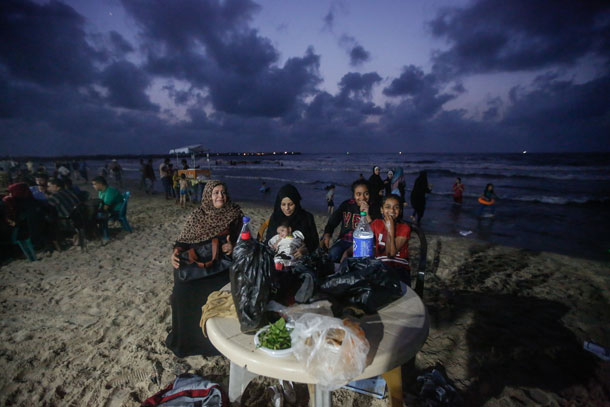
A family enjoys a respite from the sweltering heat of the beach refugee camp. (Photo: Abdel Kareem Hanna)
TOLAN: On a dusky summer night, on a stony spit of land in the middle of Gaza Harbor, five of those two million people try to enjoy a few minutes of peace. All around Ahmad and Rana Dilly and their three young children, the harbor ripples with life: fishermen hauling up their nets, kids posing for selfies on broken concrete blocks and rebar, remnants of an old bombing raid.
[NIMNIM FAMILY]
Ahmad and Rana invite me to join them under their beach umbrella. We sit in plastic chairs. Rana pours us mango soda; with a smile, Ahmad insists that I sample some chocolate wafers. Their three young children eye me shyly, nibbling on chips.
The Dillys have the same problems as many Gaza families. Ahmad’s a money changer. An Israeli missile destroyed his shop in 2014. He rebuilt it. And, like most Gazans, they have to contend with the salty water from the taps, and the inherent risks of disease from the trucked water they rely on. But these problems mean little to them compared to their wish to feel safe, and to enjoy fleeting moments like this of living as a normal family.
DILLY: I want just to change something for my family and my kids. I want to do something, to get them to see something different. I’m looking for my family just to feel safe.
In the distance, we hear an explosion. Ahmad pauses for a short moment, then ignores it. He says, I come here, just to forget everything…
For Living on Earth, I’m Sandy Tolan in the Gaza Strip.
Links
Living on Earth wants to hear from you!
Living on Earth
62 Calef Highway, Suite 212
Lee, NH 03861
Telephone: 617-287-4121
E-mail: comments@loe.org
Newsletter [Click here]
Donate to Living on Earth!
Living on Earth is an independent media program and relies entirely on contributions from listeners and institutions supporting public service. Please donate now to preserve an independent environmental voice.
NewsletterLiving on Earth offers a weekly delivery of the show's rundown to your mailbox. Sign up for our newsletter today!
 Sailors For The Sea: Be the change you want to sea.
Sailors For The Sea: Be the change you want to sea.
 The Grantham Foundation for the Protection of the Environment: Committed to protecting and improving the health of the global environment.
The Grantham Foundation for the Protection of the Environment: Committed to protecting and improving the health of the global environment.
 Contribute to Living on Earth and receive, as our gift to you, an archival print of one of Mark Seth Lender's extraordinary wildlife photographs. Follow the link to see Mark's current collection of photographs.
Contribute to Living on Earth and receive, as our gift to you, an archival print of one of Mark Seth Lender's extraordinary wildlife photographs. Follow the link to see Mark's current collection of photographs.
 Buy a signed copy of Mark Seth Lender's book Smeagull the Seagull & support Living on Earth
Buy a signed copy of Mark Seth Lender's book Smeagull the Seagull & support Living on Earth

